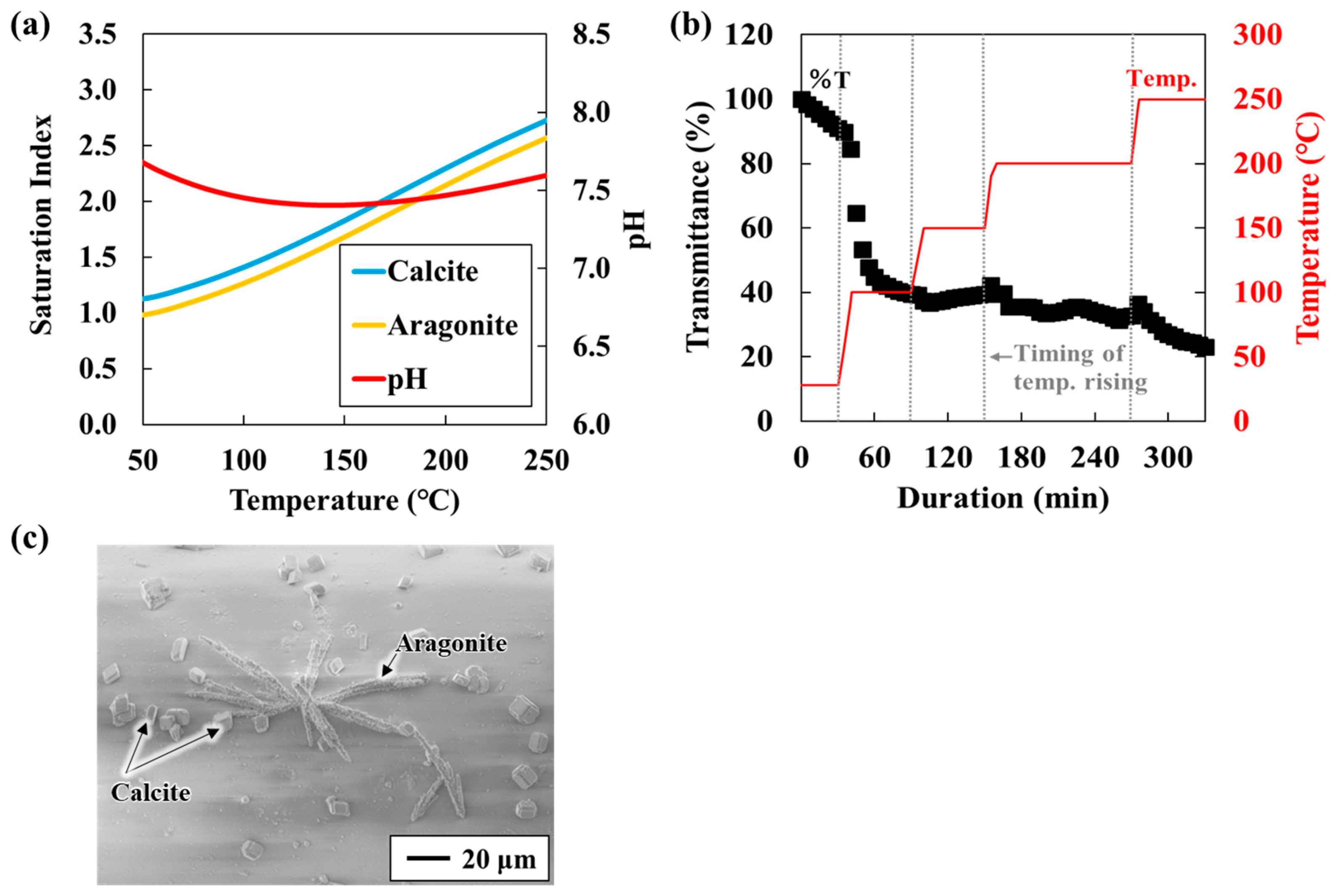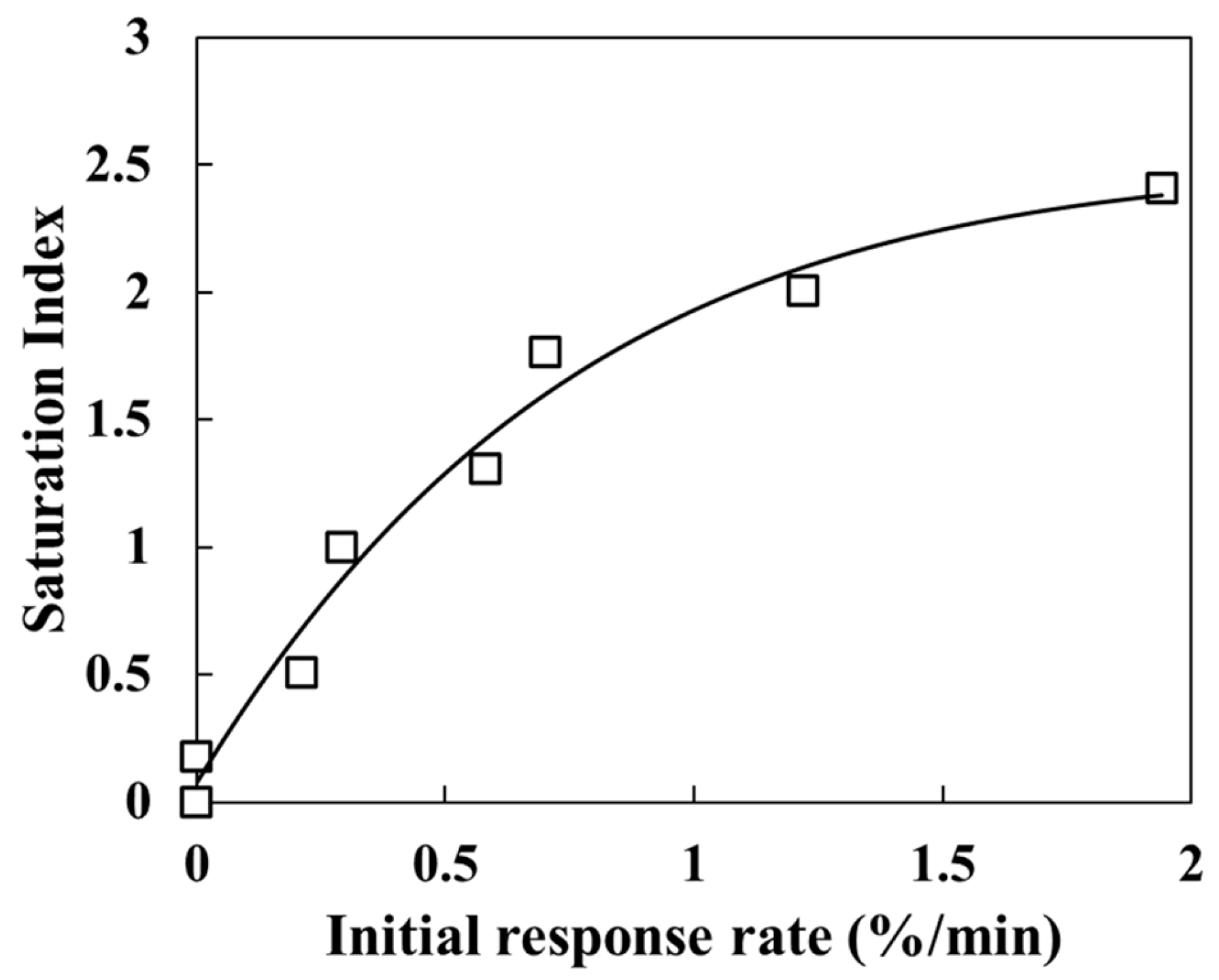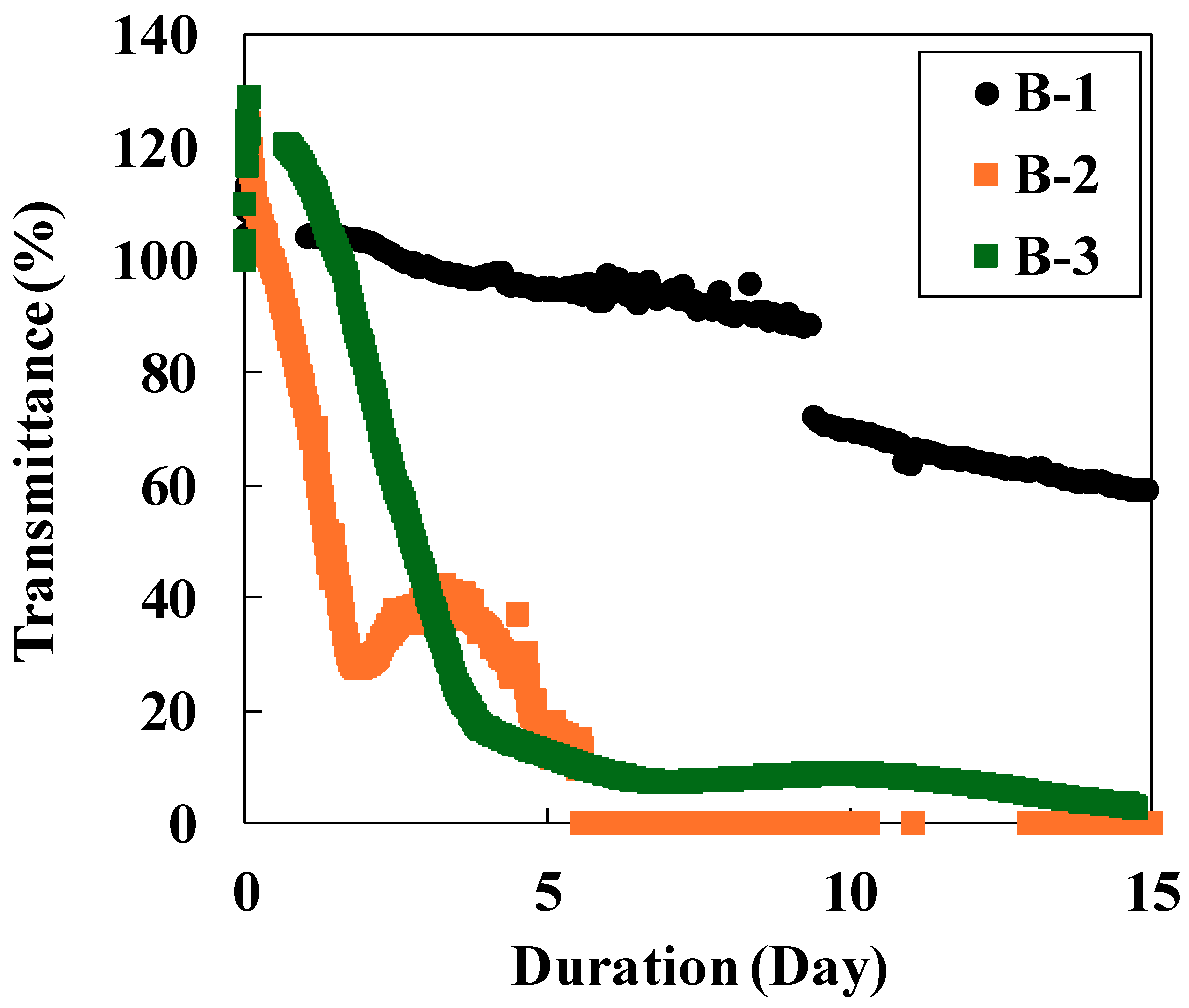Real-Time Monitoring of Secondary Mineral Precipitation During CO2–H2O–Rock Interactions Under High Temperature and Pressure Using Fiber Optic Scale Sensors
Abstract
1. Introduction
2. Materials and Methods
2.1. Reagents
2.2. Optical Fiber Sensor
2.3. Rock Sample
2.4. Experimental Apparatus and Methods (Experiments A and B)
2.5. Experimental Apparatus and Methods (Experiment C)
2.6. Experimental Conditions
2.7. Analysis
3. Results and Discussion
3.1. Carbonate Mineral Precipitation Reaction Monitoring (Experiment A)
3.2. CO2–H2O–Rock Reaction Monitoring (Experiment B)
4. Conclusions
Author Contributions
Funding
Data Availability Statement
Acknowledgments
Conflicts of Interest
References
- Agency for Natural Resources and Energy Japan’s Newest “Strategic Energy Plan” Toward Carbon Neutrality by 2050. Available online: https://www.enecho.meti.go.jp/en/category/special/article/detail_168.html (accessed on 15 May 2025).
- Ministry of the Environment Government of Japan Plan for Global Warming Countermeasures. Available online: https://www.env.go.jp/content/000249336.pdf (accessed on 15 May 2025).
- Abe, A.; Tamura, K.; Hirase, K.; Terai, A.; Tosha, T. Numerical Study on Thermal Performance of Enhanced Geothermal System with CO2 Using Multistage Hydraulic Stimulation. Sustain. Energy Res. 2025, 12, 40. [Google Scholar] [CrossRef]
- Reinsch, T.; Dobson, P.; Asanuma, H.; Huenges, E.; Poletto, F.; Sanjuan, B. Utilizing Supercritical Geothermal Systems: A Review of Past Ventures and Ongoing Research Activities. Geotherm. Energy 2017, 5, 16. [Google Scholar] [CrossRef]
- Randolph, J.B.; Saar, M.O. Coupling Carbon Dioxide Sequestration with Geothermal Energy Capture in Naturally Permeable, Porous Geologic Formations: Implications for CO2 Sequestration. Energy Procedia 2011, 4, 2206–2213. [Google Scholar] [CrossRef]
- Cong, L.; Lu, S.; Jiang, P.; Zheng, T.; Yu, Z.; Xiaoshu, L. CO2 Sequestration and Soil Improvement in Enhanced Rock Weathering: A Review from an Experimental Perspective. Greenh. Gases Sci. Technol. 2024, 14, 1122–1138. [Google Scholar] [CrossRef]
- Younger, P.L. Geothermal Energy: Delivering on the Global Potentia. Energies 2015, 8, 11737–11754. [Google Scholar] [CrossRef]
- Gislason, S.R.; Wolff-Boenisch, D.; Stefansson, A.; Oelkers, E.H.; Gunnlaugsson, E.; Sigurdardottir, H.; Sigfusson, B.; Broecker, W.S.; Matter, J.M.; Stute, M.; et al. Mineral Sequestration of Carbon Dioxide in Basalt: A Pre-Injection Overview of the CarbFix Project. Int. J. Greenh. Gas Control 2010, 4, 537–545. [Google Scholar] [CrossRef]
- Gysi, A.P.; Stefánsson, A. CO2-Water-Basalt Interaction. Low Temperature Experiments and Implications for CO2 Sequestration into Basalts. Geochim. Cosmochim. Acta 2012, 81, 129–152. [Google Scholar] [CrossRef]
- Schaef, H.T.; McGrail, B.P.; Owen, A.T. Basalt Reactivity Variability with Reservoir Depth in Supercritical CO2 and Aqueous Phases. Energy Procedia 2011, 4, 4977–4984. [Google Scholar] [CrossRef]
- Aradóttir, E.S.P.; Sonnenthal, E.L.; Björnsson, G.; Jónsson, H. Multidimensional Reactive Transport Modeling of CO2 Mineral Sequestration in Basalts at the Hellisheidi Geothermal Field, Iceland. Int. J. Greenh. Gas Control 2012, 9, 24–40. [Google Scholar] [CrossRef]
- Alfredsson, H.A.; Hardarson, B.S.; Franzson, H.; Gislason, S.R. CO2 Sequestration in Basaltic Rock at the Hellisheidi Site in SW Iceland: Stratigraphy and Chemical Composition of the Rocks at the Injection Site. Miner. Mag. 2008, 72, 1–5. [Google Scholar] [CrossRef]
- Gysi, A.P.; Stefánsson, A. CO2-Water-Basalt Interaction. Numerical Simulation of Low Temperature CO2 Sequestration into Basalts. Geochim. Cosmochim. Acta 2011, 75, 4728–4751. [Google Scholar] [CrossRef]
- Wang, H.; Zeuschner, J.; Eremets, M.; Troyan, I.; Willams, J. Stable Solid and Aqueous H2CO3 from CO2 and H2O at High Pressure and High Temperature. Sci. Rep. 2016, 6, 19902. [Google Scholar] [CrossRef]
- Kaszuba, J.; Yardley, B.; Andreani, M. Experimental Perspectives of Mineral Dissolution and Precipitation Due to Carbon Dioxide-Water-Rock Interactions. Rev. Miner. Geochem. 2013, 77, 153–188. [Google Scholar] [CrossRef]
- Javanbakht, G.; Sedghi, M.; Welch, W.; Goual, L. Molecular Dynamics Simulations of CO2/Water/Quartz Interfacial Properties: Impact of CO2 Dissolution in Water. Langmuir 2015, 31, 5812–5819. [Google Scholar] [CrossRef] [PubMed]
- Wolf, G.H.; Chizmeshya, A.V.G.; Diefenbacher, J.; McKelvy, M.J. In Situ Observation of CO2 Sequestration Reactions Using a Novel Microreaction System. Environ. Sci. Technol. 2004, 38, 932–936. [Google Scholar] [CrossRef] [PubMed]
- Zotzmann, J.; Hastreiter, N.; Mayanna, S.; Reinsch, T.; Regenspurg, S. A Fibre-Optical Method for Monitoring Barite Precipitation at High Pressure/High Temperature Conditions. Appl. Geochem. 2021, 127, 104906. [Google Scholar] [CrossRef]
- Okazaki, T.; Kuramitz, H.; Watanabe, T.; Ueda, A. Scale Sensor: Rapid Monitoring of Scale Deposition and Inhibition Using Fiber Optics in a Geothermal System and Comparison with Other Monitoring Devices. Geothermics 2021, 93, 102069. [Google Scholar] [CrossRef]
- Okazaki, T.; Imai, K.; Tan, S.Y.; Yong, Y.T.; Rahman, F.A.; Hata, N.; Taguchi, S.; Ueda, A.; Kuramitz, H. Fundamental Study on the Development of Fiber Optic Sensor for Real-Time Sensing of CaCO3 Scale Formation in Geothermal. Anal. Sci. 2015, 31, 177–183. [Google Scholar] [CrossRef]
- Satake, S.; Hosoki, A.; Suka, A.; Hoshino, Y.; Yang, H.; Ueda, A.; Kuramitz, H.; Terai, A. Scale Evaluation in Geothermal Fluids by a Batch-Type Method Using Fiber Optic Scale Sensor. Geothermics 2025, 131, 103387. [Google Scholar] [CrossRef]
- Satake, S.; Hosoki, A.; Okazaki, T.; Ueda, A.; Kuramitz, H.; Terai, A. Real-Time Monitoring of CaCO3 Precipitation Using Fiber Optics Scale Sensor Under High Temperature and Pressure Conditions. In Proceedings of the 2024 IEEE SENSORS, Kobe, Japan, 20–23 October 2024. [Google Scholar]
- Satake, S.; Yang, H.; Mori, K.; Hoshino, Y.; Ueda, A.; Kuramitz, H.; Masuoka, K.; Enomoto, H.; Terai, A. CO2 Geothermal Power Generation: Laboratory Experiment on the Interaction Between Carbonated Water and Rishiri Island Basalt in the Vicinity of Injection Wells. Energies 2025, 18, 2251. [Google Scholar] [CrossRef]
- Parkhurst, D.L.; Appelo, C.A.J. User’s Guide to PHREEQC (Ver2)-A Computer Program for Speciation, Batch-Reaction, One- Dimensional Transport, and Inverse Geochemical Calculations. Water Resour. Investig. Rep. 1999, 99, 312. [Google Scholar] [CrossRef]
- Xu, T.; Sonnenthal, E.; Spycher, N.; Pruess, K. TOUGHREACT—A Simulation Program for Non-Isothermal Multiphase Reactive Geochemical Transport in Variably Saturated Geologic Media: Applications to Geothermal Injectivity and CO2 Geological Sequestration. Comput. Geosci. 2006, 32, 145–165. [Google Scholar] [CrossRef]
- Oelkers, E.H.; Addassi, M. A Comprehensive and Consistent Mineral Dissolution Rate Database: Part III: Non-Silicate Minerals Including Carbonate, Sulfate, Phosphate, Halide, and Oxy-Hydroxide Minerals. Chem. Geol. 2024, 673, 122528. [Google Scholar] [CrossRef]
- Busenburg, E.; Plummer, L.N. A Comparative Study of the Dissolution Kinetics of Calcite and Aragonite. Stud. Diagenesis 1986, 1578, 139–168. [Google Scholar]
- Aagaard, P.; Helgeson, H.C. Thermodynamic and Kinetic Constraints on Reaction Rates among Minerals and Aqueous Solutions. I. Theoretical Considerations. Am. J. Sci. 1982, 282, 237–285. [Google Scholar] [CrossRef]
- Gislason, S.R.; Broecker, W.S.; Gunnlaugsson, E.; Snæbjörnsdóttir, S.; Mesfin, K.G.; Alfredsson, H.A.; Aradottir, E.S.; Sigfusson, B.; Gunnarsson, I.; Stute, M.; et al. Rapid Solubility and Mineral Storage of CO2 in Basalt. Energy Procedia 2014, 63, 4561–4574. [Google Scholar] [CrossRef]
- Bray, A.W.; Oelkers, E.H.; Bonneville, S.; Wolff-Boenisch, D.; Potts, N.J.; Fones, G.; Benning, L.G. The Effect of PH, Grain Size, and Organic Ligands on Biotite Weathering Rates. Geochim. Cosmochim. Acta 2015, 164, 127–145. [Google Scholar] [CrossRef]
- Karo, N.; Itov, G.; Mayraz, O.; Vogt, C. Carbon Dioxide Sequestration through Mineralization from Seawater: The Interplay of Alkalinity, PH, and Dissolved Inorganic Carbon. Chem. Eng. J. 2024, 500, 156380. [Google Scholar] [CrossRef]
- Heřmanská, M.; Voigt, M.J.; Marieni, C.; Declercq, J.; Oelkers, E.H. A Comprehensive and Consistent Mineral Dissolution Rate Database: Part II: Secondary Silicate Minerals. Chem. Geol. 2023, 636, 121632. [Google Scholar] [CrossRef]
- Gallup, D.L. Brine PH Modification Scale Control Technology. 2. A Review. GRC Trans. 1996, 20, 749–755. [Google Scholar]
- Marieni, C.; Matter, J.M.; Teagle, D.A.H. Experimental Study on Mafic Rock Dissolution Rates within CO2-Seawater-Rock Systems. Geochim. Cosmochim. Acta 2020, 272, 259–275. [Google Scholar] [CrossRef]
- Wolff-Boenisch, D.; Galeczka, I.M. Flow-through Reactor Experiments on Basalt-(Sea)Water-CO2 Reactions at 90 °C and Neutral PH. What Happens to the Basalt Pore Space under Post-Injection Conditions? Int. J. Greenh. Gas Control 2018, 68, 176–190. [Google Scholar] [CrossRef]
- Voigt, M.; Marieni, C.; Baldermann, A.; Galeczka, I.M.; Wolff-Boenisch, D.; Oelkers, E.H.; Gislason, S.R. An Experimental Study of Basalt–Seawater–CO2 Interaction at 130 °C. Geochim. Cosmochim. Acta 2021, 308, 21–41. [Google Scholar] [CrossRef]






| Expt. | No. | Solution | Temperature (°C) | Rock | Rock/Water | CO2 Pressure | Total Pressure | Duration |
|---|---|---|---|---|---|---|---|---|
| (MPa) | (MPa) | |||||||
| A | 1 | 5 mM CaCl2 | 25–250 | - | - | 0 | 6 | 6 h |
| and 5 mM NaHCO3 | ||||||||
| B | 1 | Distilled water | 150 | Basalt 1 g (0.14–1 mmφ) | 0.1 | 0.2 | 6 | 25 d |
| 2 | 100 mM NaHCO3 and 100 mM KCl mixed solution | 0 | 15 d | |||||
| 3 | 100 mM NaHCO3 | 15 d | ||||||
| C | 1 | Distilled water | 150 | Basalt 1 g (0.14–1 mmφ) | 0.1 | 0.2 | 6 | 1 d |
| 15 d | ||||||||
| 2 | 100 mM NaHCO3 and 100 mM KCl mixed solution | 0.1 | 0 | 6 | 1 d | |||
| 15 d |
| Chemical Composition (mg/L) | ||||||||||
|---|---|---|---|---|---|---|---|---|---|---|
| Experiment | Duration | Na | K | Ca | Mg | Fe | Al | SiO2 | Cl | SO4 |
| No. | (Days) | |||||||||
| B-1 | 25 | 91 | 55 | 2.8 | 0.4 | 1 | 1.6 | 68 | - | - |
| C-1 | 1 | 14.2 | 7.2 | 0.9 | 0.1 | 0.3 | 3.0 | 95.9 | 3.6 | 2.8 |
| 15 | 62.3 | 31.4 | 2.9 | 1.3 | 0.2 | 0.4 | 451 | 5.5 | 3.2 | |
| C-2 | 1 | 2619 | 3975 | - | - | 0.1 | 10.4 | 24.6 | 4286 | - |
| 15 | 2597 | 3865 | - | - | 0.1 | 13.8 | 55.2 | 4216 | - | |
| Duration | pH | Calcite | Siderite | Magnesite | Aragonite | Dolomite | Dawsonite | Kaolinite | Montmorillionite–Na | Illite | Nontronite–Na | Scolecite | Saponite–Na | Beidellite–Na | Magnetite | Hematite | |
|---|---|---|---|---|---|---|---|---|---|---|---|---|---|---|---|---|---|
| B-1 | 25 d | 4.1 | −5.1 | −3.3 | −5.2 | −5.2 | −9.2 | −3.5 | 4.5 | 0.9 | 2.4 | 6.3 | −0.5 | −13.9 | 3.7 | 4.6 | 7.2 |
| C-1 | 1 d | 5.1 | −3.0 | −2.1 | −3.3 | −3.1 | −5.2 | −2.7 | 5.0 | 2.2 | 3.6 | 17.6 | 1.7 | −8.9 | 4.5 | 16.0 | 17.8 |
| 15 d | 5.9 | −1.1 | −1.6 | −0.8 | −1.3 | −0.9 | −2.8 | 3.5 | 3.8 | 4.1 | 20.8 | 2.8 | 1.1 | 4.1 | 17.1 | 18.5 | |
| C-2 | 1 d | 9.1 | −0.2 | −2.8 | 0.1 | −0.4 | 0.9 | −2.2 | −4.5 | −4.9 | −3.5 | 14.4 | −4.1 | 3.9 | −6.2 | 18.4 | 18.7 |
| 15 d | 9.1 | −0.2 | −2.5 | 0.1 | −0.4 | 0.9 | −2.0 | −3.3 | −3.1 | −1.8 | 16.4 | −2.6 | 5.2 | −4.4 | 19.0 | 19.2 |
Disclaimer/Publisher’s Note: The statements, opinions and data contained in all publications are solely those of the individual author(s) and contributor(s) and not of MDPI and/or the editor(s). MDPI and/or the editor(s) disclaim responsibility for any injury to people or property resulting from any ideas, methods, instructions or products referred to in the content. |
© 2025 by the authors. Licensee MDPI, Basel, Switzerland. This article is an open access article distributed under the terms and conditions of the Creative Commons Attribution (CC BY) license (https://creativecommons.org/licenses/by/4.0/).
Share and Cite
Satake, S.; Hosoki, A.; Kuramitz, H.; Ueda, A.; Terai, A. Real-Time Monitoring of Secondary Mineral Precipitation During CO2–H2O–Rock Interactions Under High Temperature and Pressure Using Fiber Optic Scale Sensors. Energies 2025, 18, 5856. https://doi.org/10.3390/en18215856
Satake S, Hosoki A, Kuramitz H, Ueda A, Terai A. Real-Time Monitoring of Secondary Mineral Precipitation During CO2–H2O–Rock Interactions Under High Temperature and Pressure Using Fiber Optic Scale Sensors. Energies. 2025; 18(21):5856. https://doi.org/10.3390/en18215856
Chicago/Turabian StyleSatake, Sakurako, Ai Hosoki, Hideki Kuramitz, Akira Ueda, and Amane Terai. 2025. "Real-Time Monitoring of Secondary Mineral Precipitation During CO2–H2O–Rock Interactions Under High Temperature and Pressure Using Fiber Optic Scale Sensors" Energies 18, no. 21: 5856. https://doi.org/10.3390/en18215856
APA StyleSatake, S., Hosoki, A., Kuramitz, H., Ueda, A., & Terai, A. (2025). Real-Time Monitoring of Secondary Mineral Precipitation During CO2–H2O–Rock Interactions Under High Temperature and Pressure Using Fiber Optic Scale Sensors. Energies, 18(21), 5856. https://doi.org/10.3390/en18215856






